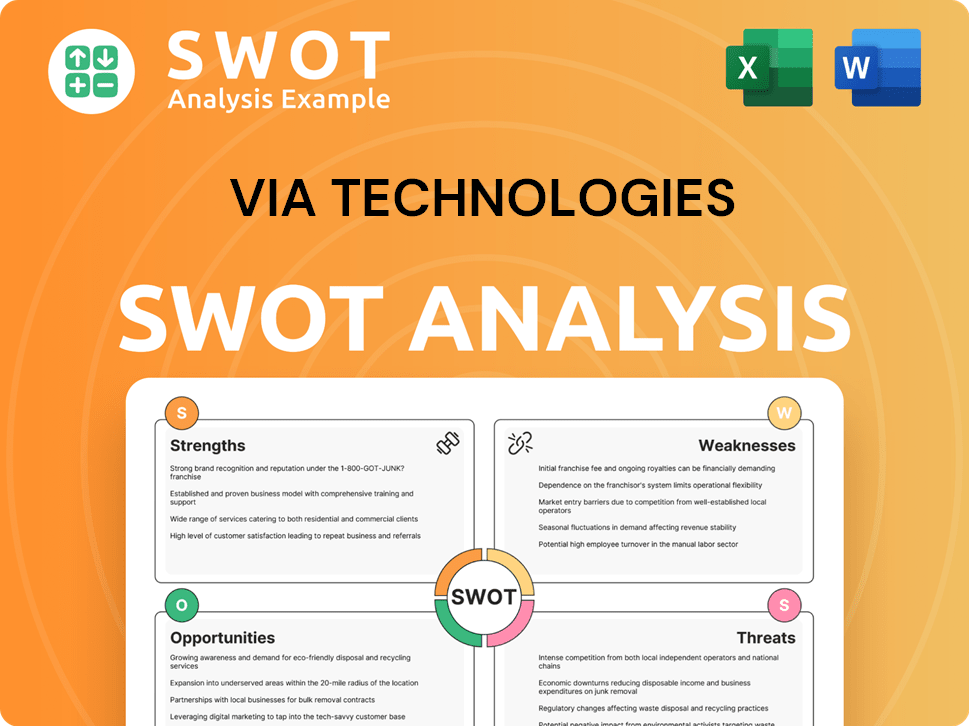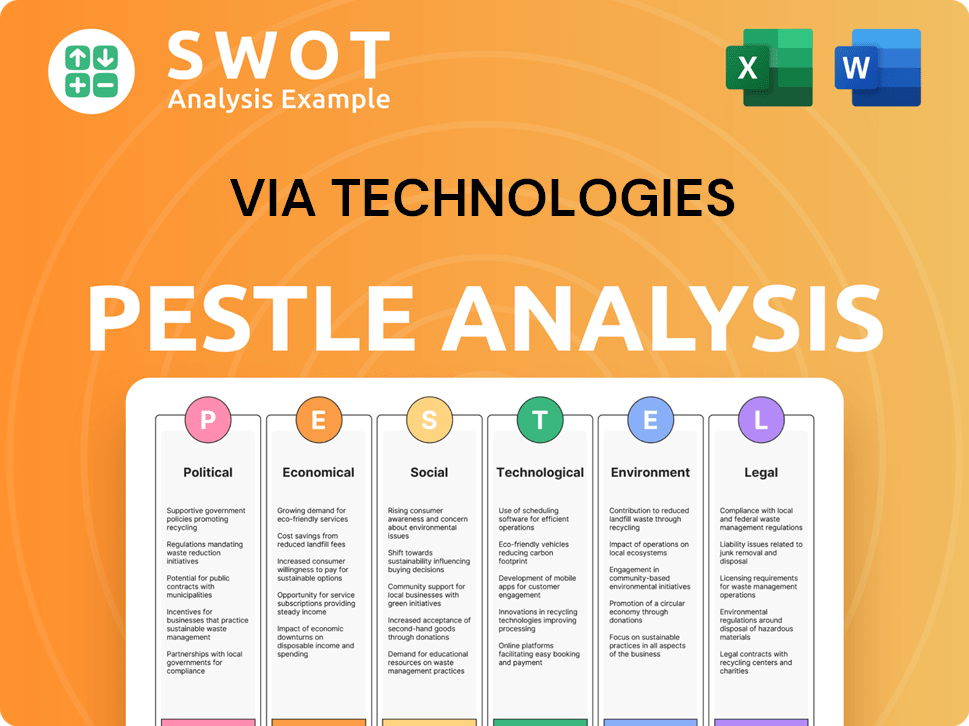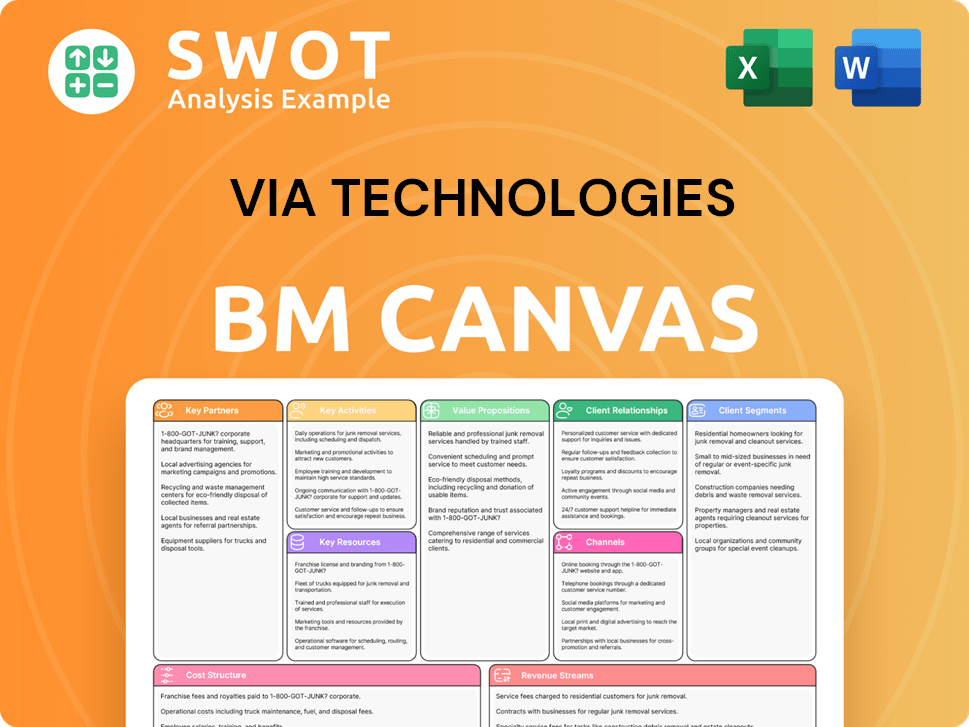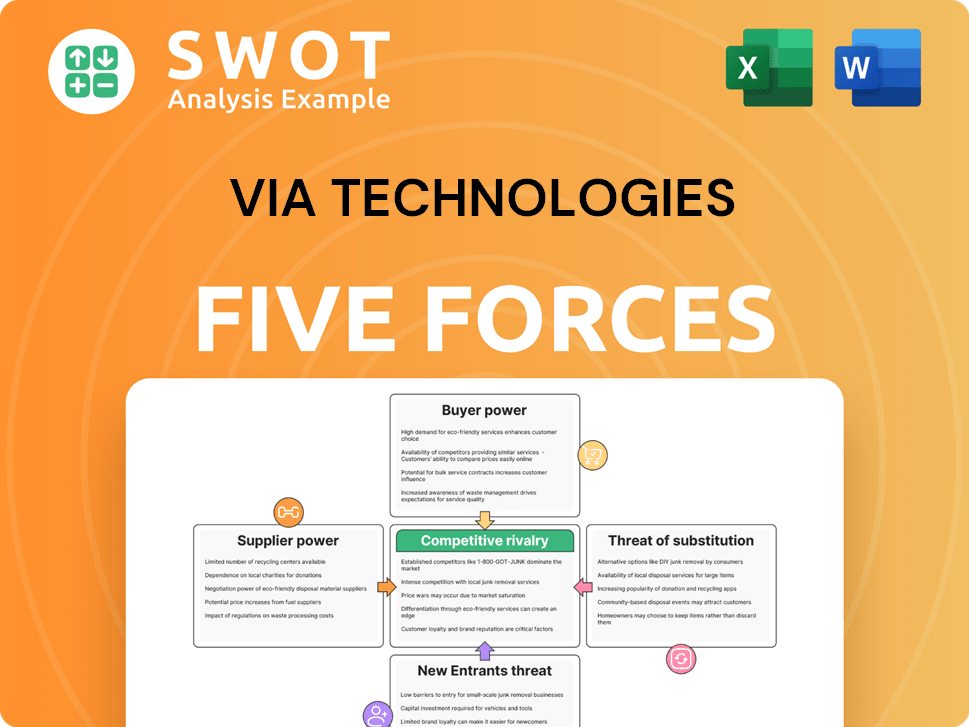VIA Technologies Bundle
How has VIA Technologies remained a tech innovator for decades?
Journey back in time to uncover the fascinating VIA Technologies SWOT Analysis, a Taiwanese tech giant that has consistently pushed the boundaries of integrated circuit design. From its humble beginnings in California to its strategic relocation to Taiwan, VIA Technologies has demonstrated remarkable resilience and adaptability. Discover how this company, once a dominant force in chipsets, has evolved to embrace the future of AI and embedded systems.

VIA Technologies' history is a testament to its ability to navigate the ever-changing tech landscape. Explore the VIA company timeline, tracing its evolution from a chipset manufacturer to a provider of VIA processors and innovative solutions. Learn about the key milestones, from its early VIA chipsets to its current focus on AI and embedded systems, and understand how VIA Technologies has consistently adapted to market demands, ensuring its enduring relevance.
What is the VIA Technologies Founding Story?
The story of VIA Technologies begins in 1987 in Fremont, California. The company was founded by Cher Wang, with a vision centered on 'Total Connectivity'. This aimed to develop technologies for affordable, feature-rich PC systems, making information and resources more accessible.
While Cher Wang is recognized as a co-founder, Wen Chi Chen, formerly of Intel, also played a key role in the early days. Chen facilitated the transfer of employees from Symphony to Taiwan to begin microprocessor production. This move was crucial for the company's initial manufacturing efforts.
In 1992, the headquarters shifted to Taipei, Taiwan. This strategic move allowed the company to capitalize on the burgeoning IT manufacturing base in Taiwan and China. VIA Technologies operates on a fabless model, focusing on design and development. They outsource silicon manufacturing to foundries like TSMC. This approach enabled VIA to concentrate on research and development, especially in integrated chipsets for the PC market.
VIA Technologies has navigated the competitive tech landscape. Here's a look at some key moments in the company's journey.
- 1987: VIA Technologies founded in Fremont, California.
- 1992: Headquarters moved to Taipei, Taiwan, to strengthen ties with the manufacturing sector.
- Early Focus: Integrated chipsets for the PC market formed a core part of their business.
- Fabless Model: VIA designs its integrated circuits and outsources manufacturing.
VIA Technologies, with its Marketing Strategy of VIA Technologies, has consistently adapted to the dynamic tech industry. The company's early focus on chipsets and its strategic shift to Taiwan highlight its commitment to innovation and manufacturing partnerships. This approach has allowed VIA to remain competitive in the evolving market.
VIA Technologies SWOT Analysis
- Complete SWOT Breakdown
- Fully Customizable
- Editable in Excel & Word
- Professional Formatting
- Investor-Ready Format

What Drove the Early Growth of VIA Technologies?
The early phase of VIA Technologies saw it establish itself as a key player in the PC component market. The VIA history includes the company's rise as a significant supplier of motherboard (core-logic) chipsets. These chipsets were crucial for PC and peripheral vendors, including ASUS. The company's growth was marked by strategic innovations and acquisitions.
By the mid-1990s, VIA Technologies was already well-known for its motherboard chipsets. A pivotal moment was in 1997 with the introduction of AGP support for Socket 7 processors through its Apollo VP3 chipset. Between 1998 and 2000, the success of its Pentium III chipsets significantly boosted VIA's market position. This period showcased VIA's ability to innovate and respond to market demands.
Around 2001, Intel shifted away from SDRAM chipsets, which created an opportunity for VIA. VIA produced the initial chipsets to connect PC-133 memory with Pentium 3 chips. This move positioned VIA as a leader, challenging Intel's Rambus initiative. This strategic move highlighted VIA's adaptability and foresight in the industry.
VIA diversified its core-logic business through acquisitions, forming CPU, graphics, and sound divisions. In 1999, the company acquired most of Cyrix and Centaur Technology, entering the x86 microprocessor market. This led to the production of VIA C3, C7, and Nano processors. In February 2005, VIA celebrated the production of its 100 millionth VIA AMD chipset.
VIA Labs Inc. (VLI) was founded in July 2008 to develop USB 3.0, USB 4, USB Type-C, and USB PD controllers. In 2021, VIA Labs experienced strong growth due to the adoption of its USB Type-C and USB PD devices. The launch of the world's first USB4 chip in Q3 2021 further solidified its market leadership. For the period of January through April 2025, consolidated net sales were NT$2,655.277 million (approximately US$80.882 million). You can learn more about the company's financial structure by reading Revenue Streams & Business Model of VIA Technologies.
VIA Technologies PESTLE Analysis
- Covers All 6 PESTLE Categories
- No Research Needed – Save Hours of Work
- Built by Experts, Trusted by Consultants
- Instant Download, Ready to Use
- 100% Editable, Fully Customizable

What are the key Milestones in VIA Technologies history?
The VIA Technologies company has achieved several significant milestones in the technology industry. These achievements include pioneering advancements in chipsets and processors, strategic acquisitions, and expansions into new markets.
| Year | Milestone |
|---|---|
| 1997 | VIA pioneered AGP support for Socket 7 processors with its Apollo VP3 chipset. |
| 1999 | VIA acquired Cyrix and Centaur Technology, entering the x86 microprocessor market. |
| 2013 | VIA, through its Zhaoxin joint venture, began producing x86-compatible CPUs and integrated-graphics systems. |
| 2024 | VIA Technologies' Mobile360 Safety Solution for Heavy Equipment received the 2024 Mine Safety and Technology Innovation Award from the National Institute for Occupational Safety and Health (NIOSH). |
| 2024 | VIA launched two new NVIDIA Jetson-powered Edge AI PCs, the VIA AMOS-9100 and VIA AMOS-9000, for autonomous mobile robots (AMRs), automated guided vehicles (AGVs), and industrial automation. |
VIA Technologies has consistently demonstrated innovation in the semiconductor industry. A key innovation was the introduction of PC133 SDRAM and later DDR SDRAM memory for AMD processor platforms, challenging Intel's push for RDRAM. More recently, VIA has focused on AI-powered solutions, as seen with their Mobile360 Safety Solution and new Edge AI PCs.
VIA's early chipsets, like the Apollo VP3, were crucial in supporting new technologies like AGP. This allowed VIA to establish itself as a key player in the chipset market, providing essential components for various computer systems.
The acquisition of Cyrix and Centaur Technology allowed VIA to develop its own x86 processors. This move expanded VIA's product portfolio and increased its presence in the competitive processor market.
VIA's support for PC133 SDRAM and DDR SDRAM for AMD processors provided a cost-effective alternative to Intel's RDRAM. This strategic move helped VIA gain market share and influence in the memory market.
VIA's recent focus on AI-powered solutions, such as the Mobile360 Safety Solution, demonstrates its ability to adapt to new market demands. This showcases VIA's commitment to innovation.
The launch of the VIA AMOS-9100 and VIA AMOS-9000 series of Edge AI PCs, powered by NVIDIA Jetson, signifies VIA's expansion into the burgeoning market of autonomous systems. These PCs are designed to enhance industrial automation.
The NIOSH award for the Mobile360 Safety Solution highlights VIA's commitment to safety and innovation. This recognition underscores the effectiveness of VIA's technology in addressing critical industry challenges.
VIA Technologies has faced considerable challenges, including intense competition and legal battles. Intel's accusations of technology infringement and subsequent lawsuits significantly impacted VIA's financial performance. Despite these hurdles, VIA managed to increase its revenue substantially in the early 2000s, demonstrating resilience in a competitive market.
Intel's legal actions against VIA created significant financial and operational pressures. These disputes diverted resources and impacted VIA's ability to compete effectively in the market.
The semiconductor industry is highly competitive, with giants like Intel holding a significant market share. This competition has forced VIA to continuously innovate and adapt to maintain its position. VIA's revenue increased by 174% over 1999, jumping from a US$350 million to a US$1 billion company in just one year.
The legal battles and market pressures led to a considerable drop in VIA's earnings. In 2001, VIA's third-quarter earnings decreased by 64% year-on-year, and the full-year profit forecast was slashed by 38%.
VIA has shown resilience by adapting its product portfolio to meet evolving industry demands. This includes shifting focus to AI-powered solutions and embedded systems to stay competitive.
The semiconductor market is dominated by major players, making it difficult for smaller companies to gain significant market share. VIA's ability to innovate and find niche markets is crucial for its survival.
VIA's ability to stay relevant depends on its capacity to integrate cutting-edge technologies. This includes developing processors, chipsets, and systems that meet the evolving needs of the industry.
VIA Technologies Business Model Canvas
- Complete 9-Block Business Model Canvas
- Effortlessly Communicate Your Business Strategy
- Investor-Ready BMC Format
- 100% Editable and Customizable
- Clear and Structured Layout

What is the Timeline of Key Events for VIA Technologies?
The brief history of the VIA Technologies company showcases a journey from its foundation to its current positioning in the tech industry. Founded in 1987 by Cher Wang, VIA Technologies quickly established itself as a key player in the PC component market. The company's evolution includes strategic moves like the relocation of its headquarters to Taipei, Taiwan, in 1992, and significant acquisitions such as Cyrix and Centaur Technology. VIA's innovation in chipset technology and processors, including the VIA Nano and its involvement in the x86 market through Zhaoxin, have shaped its trajectory. Recent developments, such as the launch of new graphics cards and the recognition of its safety solutions, highlight VIA's ongoing commitment to technological advancement. In April 2025, VIA Technologies announced consolidated net sales of NT$602.92 million (US$18.37 million approximately), indicating its current market position.
| Year | Key Event |
|---|---|
| 1987 | VIA Technologies is founded in Fremont, California, by Cher Wang. |
| 1992 | The company's headquarters are relocated to Taipei, Taiwan, to strengthen ties with the manufacturing base. |
| 1996 | VIA establishes itself as an important supplier of PC components with chipsets for the Socket 7 platform. |
| 1997 | VIA pioneers AGP support for Socket 7 processors with the Apollo VP3 chipset. |
| 1999 | VIA acquires most of Cyrix and Centaur Technology, entering the x86 microprocessor market. |
| 2001 | VIA establishes the S3 Graphics joint venture and faces legal challenges from Intel regarding chipset technology. |
| 2005 | VIA celebrates the production of its 100 millionth VIA AMD chipset. |
| 2008 | VIA unveils the VIA Nano processor for ultra-mobile PCs and founds VIA Labs, Inc. (VLI) as a subsidiary focused on USB 3.0. |
| 2011 | VIA announces its first x86 quad-core processors and sells its shares in S3 Graphics to HTC. |
| 2013 | Through its Zhaoxin joint venture, VIA continues to create x86-64 compatible CPU designs. |
| January 2024 | VIA launches a new graphics card dedicated to embedded applications. |
| October 2024 | VIA's Mobile360 Safety Solution for Heavy Equipment wins the 2024 Mine Safety and Technology Innovation Award from NIOSH. |
| November 2024 | VIA unveils two new NVIDIA Jetson-powered Edge AI PCs for AMRs, AGVs, and industrial automation. |
| December 2024 | VIA Mobile360 Forklift Safety System receives the 2024 Top Software & Tech Award. |
| April 2025 | VIA Technologies announces consolidated net sales of NT$602.92 million (US$18.37 million approximately). |
VIA Technologies positions itself as a leading 'AI Enabler,' offering comprehensive AI solutions across various industries. This strategic focus aims to leverage its experience and become a significant player in the AI landscape. The company prioritizes innovation and collaboration to achieve its goals, concentrating on the development of intelligent edge systems.
VIA's focus on AI-powered solutions aligns with significant industry trends. Global IT spending is projected to increase by 9.3% in 2025. Worldwide spending on AI is expected to grow at a compound annual growth rate of 29% from 2024 to 2028. This positions VIA to capitalize on the expanding market for AI technologies.
VIA is actively developing smart IoT solutions for smart factories and smart buildings. The company's commitment to automotive safety solutions, such as the Mobile360 Commercial Vehicle Safety System, demonstrates its focus on integrating AI and computer vision. These efforts reflect VIA's vision of enabling total connectivity through innovative technologies.
VIA's future will likely be driven by its continued investment in AI, computer vision, and embedded systems. This approach is consistent with its founding vision of promoting total connectivity through technological innovation. The company's strategic focus and market alignment suggest a promising outlook for VIA Technologies.
VIA Technologies Porter's Five Forces Analysis
- Covers All 5 Competitive Forces in Detail
- Structured for Consultants, Students, and Founders
- 100% Editable in Microsoft Word & Excel
- Instant Digital Download – Use Immediately
- Compatible with Mac & PC – Fully Unlocked

Related Blogs
- What is Competitive Landscape of VIA Technologies Company?
- What is Growth Strategy and Future Prospects of VIA Technologies Company?
- How Does VIA Technologies Company Work?
- What is Sales and Marketing Strategy of VIA Technologies Company?
- What is Brief History of VIA Technologies Company?
- Who Owns VIA Technologies Company?
- What is Customer Demographics and Target Market of VIA Technologies Company?
Disclaimer
All information, articles, and product details provided on this website are for general informational and educational purposes only. We do not claim any ownership over, nor do we intend to infringe upon, any trademarks, copyrights, logos, brand names, or other intellectual property mentioned or depicted on this site. Such intellectual property remains the property of its respective owners, and any references here are made solely for identification or informational purposes, without implying any affiliation, endorsement, or partnership.
We make no representations or warranties, express or implied, regarding the accuracy, completeness, or suitability of any content or products presented. Nothing on this website should be construed as legal, tax, investment, financial, medical, or other professional advice. In addition, no part of this site—including articles or product references—constitutes a solicitation, recommendation, endorsement, advertisement, or offer to buy or sell any securities, franchises, or other financial instruments, particularly in jurisdictions where such activity would be unlawful.
All content is of a general nature and may not address the specific circumstances of any individual or entity. It is not a substitute for professional advice or services. Any actions you take based on the information provided here are strictly at your own risk. You accept full responsibility for any decisions or outcomes arising from your use of this website and agree to release us from any liability in connection with your use of, or reliance upon, the content or products found herein.